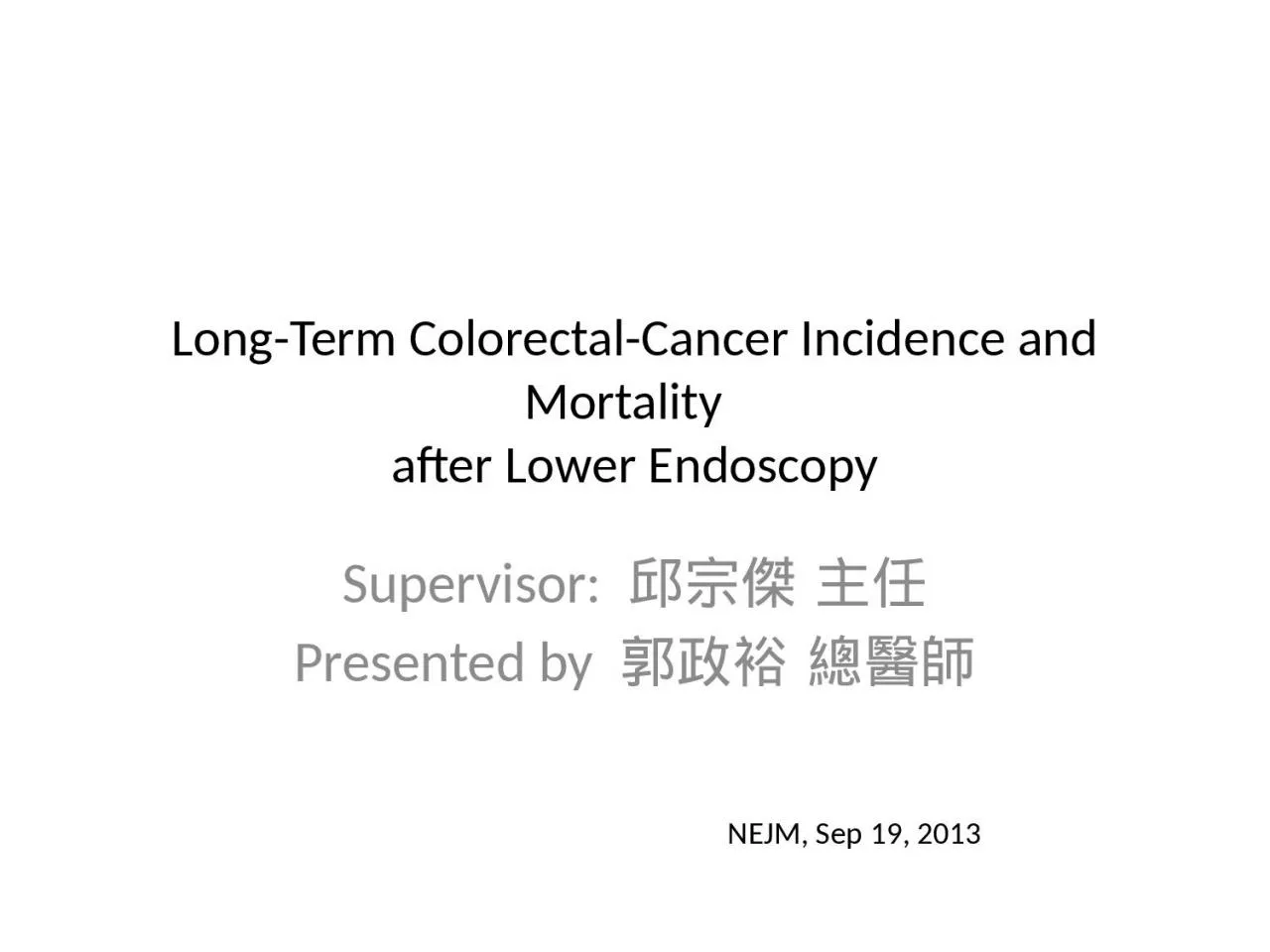

after Lower Endoscopy Supervisor 邱宗傑 主任 Presented by 郭政裕 總醫師 NEJM Sep 19 2013 PolypCancer sequency Morphology Anatomic Distribution and Cancer Potential of Colonic Polyps Annals Surgery ID: 920735
Download Presentation The PPT/PDF document "Long-Term Colorectal-Cancer Incidence an..." is the property of its rightful owner. Permission is granted to download and print the materials on this web site for personal, non-commercial use only, and to display it on your personal computer provided you do not modify the materials and that you retain all copyright notices contained in the materials. By downloading content from our website, you accept the terms of this agreement.
Slide1
Long-Term Colorectal-Cancer Incidence and Mortality after Lower Endoscopy
Supervisor: 邱宗傑 主任Presented by 郭政裕 總醫師
NEJM
, Sep 19, 2013
Slide2Polyp-Cancer sequency
?
Slide3Slide4Morphology, Anatomic Distribution and Cancer Potential of Colonic Polyps. Annals Surgery
1979;190:679-683.
Slide5Morphology, Anatomic Distribution and Cancer Potential of Colonic Polyps. Annals Surgery
1979;190:679-683.
Slide6Familiar adenomatous polyposis
(FAP)
APC
mutations (
Adenomatous
polyposis
coli
)
An
inherited cancer-predisposition
syndrome
more than 100
adenomatous
polyps
in
carriers of the
mutant
gene
, the risk of colorectal cancer by the age of 40 years is almost 100%
Kathleen H. Biology Of The
APC
Tumor Suppressor
. J
Clin
Oncol
2000;18:1967-1979
.
Slide7Slide8Animal model:
The Apcmin mouse
chemical mutagenesis that
introduced a chain-terminating mutation at
nucleotide 2549
in
mApc
develop
numerous intestinal adenomas
in which
the remaining wild-type allele is somatically
inactivated
during adenoma development
Kathleen H. Biology Of The
APC
Tumor Suppressor
. J
Clin
Oncol
2000;18:1967-1979
.
Slide9Sporadic colorectal adenoma and cancers
APC Somatic mutations and deletions that inactivate both copies of APC
are present in most patients
Wild-type
APC
Mutations of β-
catenin
resistent
to the
β-
catenin
degradation complex
Kathleen H. Biology Of The
APC
Tumor Suppressor
. J
Clin
Oncol
2000;18:1967-1979
.
Slide10Sanford D.
Moleucular
Basis of Colorectal Cancer. N
Engl
J Med 2009;361:2449-60.
Slide11Sanford D.
Moleucular
Basis of Colorectal Cancer. N
Engl
J Med 2009;361:2449-60.
Slide12Slide13Methods
Study populationProspective cohort studyThe Nurses’ Health Study: 121,700 U.S. female nurses (30~55 y/o), since 1976The Health Professionals Follow-up Study: 51,529 U.S. male health professionals (40~75 y/o),
sinc
1986
Exclusion criteria
History of cancer
Ulcerative colitis
Colorectal polyps
Familiar
polyposis
syndromes
Previous lower endoscopy
Slide14Observational studies
Enrolled: n=88,902 (31,736 men, 57,166 women)1998~2008Questionnaire and collect information every 2 year (Low GI endoscopy: sigmoidscopy or colonoscopy) Incidence analysis in 2010, mortality analysis in 2012
Slide15Polyps
Adenomatous polyps Advanced adenoma (≥10 mm, tubulovillus or villous, or high-grade dysplasia)
High-risk adenoma ( numbers ≥ 3)
Colonoscopic
polypectomy
: excision of
comfirmed
adenomatous
polyps (excluding
hyperplastic
polyps)
Negative endoscopy: no adenomas or
CRCs
Slide16Molecular analysis
Microsatellite instability statusBRAF (codon 600)KRAS (
codon
12 and 13)
PIK3CA
(
exons
9 and 20)
DNA
methylation
(8
CpG
island
methylator
phenotype,
CIMP
)
Specific
promotors
:
MLH1
,
CACNA1G
,
CDKN2A
, CRABP1, IGF2, NEUROG1, RUNX3, and SOCS1)Long interspersed nucleotide element 1 (LINE-1)
Slide17Slide18Results88,902 participants, follow-up for 22 years
Received endoscopy vs. without endoscopyColorectal cancer: 1815 incident cases (2%)
Slide19Slide20Slide21Screen colonscopy interval
Slide22Surveillance colonoscopy interval after removal of adenomatous polyps
Slide23Slide24Slide25Slide26Summary
Low gastrointestinal endoscopy is associated with a low incidence and low mortality of colorectal cancerTumor molecular features of the serrated pathway might be involved in the development of cancer within
5
years after colonoscopy
Slide27Thanks for your attention!